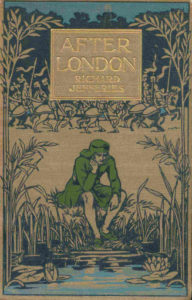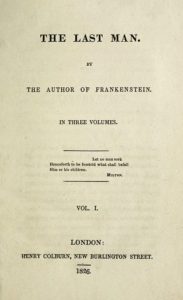Most popular articles for January 2024:
Gather ’round, ye lords and ladies. We’re traveling back in time to Georgian and Victorian England, to discover two of the first post-apocalyptic novels ever written…
Recently, while writing a rambling love letter to the post-apocalyptic fiction genre, I began to wonder about the origins of that genre. (Or subgenre, if you like.) When and where did it all start? What was the first post-apocalyptic novel? Who were the first writers to tackle this weighty subject, and why?
Today, most literary historians point to Mary Wollstonecraft Shelley as one of the first — if not the first — authors to write a work of post-apocalyptic fiction. The novel is called The Last Man, and you can read it for free through Project Gutenberg, Google Books, and other sources.
A word of warning though. This might be the dullest and driest post-apocalyptic novel you ever read. Leave it to those 19th-century English writers to suck the life out of a thrilling genre. [Pauses to duck incoming tomatoes.]
But this isn’t a critique of Mary Shelley’s novel. Well, it sort of is. But that’s secondary. My main purpose here is to further explore the origin and evolution of post-apocalyptic stories and novels.
Let’s start by looking at this trailblazing work from the author of Frankenstein.
The Last Man: the First Post-Apocalyptic Novel
Shelley’s The Last Man was published in 1826, eight years after the publication of her most famous work, Frankenstein. The Last Man tells the story of Lionel Verney, the adopted son of an impoverished nobleman.
The story is set in the future (well into the future, from the time when Mary Shelley wrote it). It takes places between 2073 and 2100. The story is told in the first person point-of-view, from Lionel’s perspective, and it’s mostly a flashback.
Lionel is sort of a wild child. His parents die, leaving him to look after his younger sister. They grow up largely without parental supervision, or any kind of guidance at all. Still, Lionel does his best to care for his little sister.
Eventually, Lionel goes off to fight in a war between the Greeks and the Turks. Around this time, a plague begins to spread across Europe and into the Americas. Society breaks down. Survivors huddle together in tribe-like factions. One by one, they fall to the plague’s wrath.
All but Lionel, that is. He is left alone to recount, in ponderous prose, all the events of his tumultuous life. Lionel befriends a sheepdog and spends the rest of his days wandering the post-apocalyptic landscape.
The end.
Okay, so there’s more to it than that…
In this novel, Shelly has a lot to say about society, religion, education, etc. There’s quite a bit of social critique in this book. Just don’t read it expecting the thrills and chills of the modern post-apocalyptic fiction genre we know today.
Mary Shelly wrote The Last Man at the height of the Romantic period in England. And while the passages sometimes flow with poetic fluidity, they also hold the reader at arm’s length. It’s hard to connect with the characters and scenes in this story.
In a more modern post-apocalyptic novel, you would experience the story as if you were actually there, with a “fly-on-the-wall” perspective. In The Last Man, you have the story conveyed to you by a narrator. At times, I felt like I was sitting in a classroom, having the story recounted by an English professor.
The first apocalyptic novel received harsh reviews from critics of the era. The Literary Gazette, a British literary magazine, called Shelley’s novel “A sickening repetition of horrors.” Maybe they wanted a happier, more joyful apocalypse?
The Monthly Review, a British periodical from that period, called The Last Man “the offspring of a diseased imagination, and of a most polluted taste.”
After London: The Apocalypse Returneth
Technically speaking, The Last Man was the first apocalypse / post-apocalyptic novel written. But in that story, the end of civilization is used almost like a literary device. Its main purpose, it seems, is to isolate the character with his thoughts. In other words, Mary Shelley’s apocalyptic story isn’t about the apocalypse so much as the worldview of the protagonist.
That’s my take, anyway.

About 60 years later, the world would receive another post-apocalyptic fiction novel by another English writer. This time, the doomsday story came from a Victorian-era nature writer named Richard Jefferies.
After London; Or, Wild England, by Richard Jeffries shows what happens to the author’s country after some unspecified apocalyptic event reduces the population to a small groups of survivors.
It’s also available on Project Gutenberg, by the way.
After London was one of the first post-apocalyptic novels that focused on the effects of apocalypse, showing how it affected the natural world in particular. Jeffries was a nature writer, after all. So you would expect him speculate about the natural side of things, in a world with far fewer humans.
Common Threads at the End of the World
Despite their many differences, these two early works of post-apocalyptic fiction bear some similarities:
- Shelley used the apocalypse as a kind of metaphor, highlighting the failings of humanity and societal institutions.
- Jeffries used the apocalypse to envision a pastoral world where nature rebounds from human overuse and destruction. But even with this return to feudalism, human survivors find a way to muck things up.
The first part of After London describes how nature reclaims the English countryside. Jeffries offers a long and loving depiction of what this would look like. We have pages and pages of this kind of prose:
“Hawthorn bushes sprang up among them, and, protected by the briars and thorns from grazing animals, the suckers of elm-trees rose and flourished. Sapling ashes, oaks, sycamores, and horse-chestnuts, lifted their heads. Of old time the cattle would have eaten off the seed leaves with the grass so soon as they were out of the ground, but now most of the acorns that were dropped by birds, and the keys that were wafted by the wind, twirling as they floated, took root and grew into trees. By this time the brambles and briars had choked up and blocked the former roads, which were as impassable as the fields.”
Beautiful, isn’t it? Any writer of post-apocalyptic fiction could benefit by reading After London. It helps us envision, in great detail, what the world would look like in the wake of our absence.
Later in the novel, Jeffries shifts gears to describe what remains of London. And it’s a stark contrast from his loving portrayal of resurging nature. In chapter 23, Felix the protagonist returns to the city to find a desolate wasteland:
“The ground looked, indeed, as if it had been burnt, but there were no charred stumps of timber such as he had seen on the sites of forest fires. The extreme dreariness seemed to oppress his spirits, and he went on and on in a heavy waking dream. Descending into a plain, he lost sight of the flaming sunset and the black waters.”
He also encounters a mysterious “yellow mist,” which might have been the cause of the apocalypse:
“Inhaling the gaseous emanations from the soil and contained in the yellow vapour, he had become narcotized, and moved as if under the influence of opium, while wide awake, and capable of rational conduct.”
After London enjoyed more success (in its time) than Shelley’s The Last Man. But Shelley was the true pioneer of the two. Both works helped to create and shape a genre that is still going strong today. We owe them thanks.
